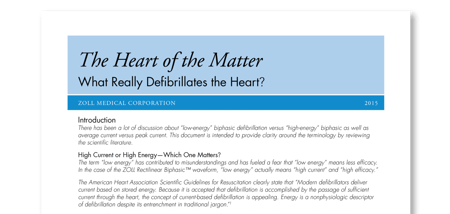The Heart of the Matter: What Really Defibrillates the Heart?

There has been a lot of discussion about “low-energy” biphasic defibrillation vs. “high-energy” biphasic, as well as average current vs. peak current.
Although delivered energy levels are selected for defibrillation, it is the transmyocardial current flow that achieves defibrillation; the electrical current correlates well with successful defibrillation and cardioversion.
The American Heart Association Scientific Guidelines for Resuscitation clearly state: “Modern defibrillators deliver current based on stored energy. Because it is accepted that defibrillation is accomplished by the passage of sufficient current through the heart, the concept of current-based defibrillation is appealing. Energy is a nonphysiologic descriptor of defibrillation despite its entrenchment in traditional jargon.”1
All ZOLL® defibrillators deliver a Rectilinear Biphasic waveform (RBW) that provides more current than the high-energy biphasic others use. This capability is particularly important for the difficult-to-defibrillate, high-impedance patient.
This document is intended to provide clarity around the terminology by reviewing the scientific literature.
1 Link MS, Atkins DL, et al. Automated external defibrillators, defibrillation, cardioversion, and pacing. 2010 American Heart Association Guidelines for Cardiopulmonary Resuscitation and Emergency Cardiovascular Care. Circulation. 2010;122(suppl 3):S706 –S719